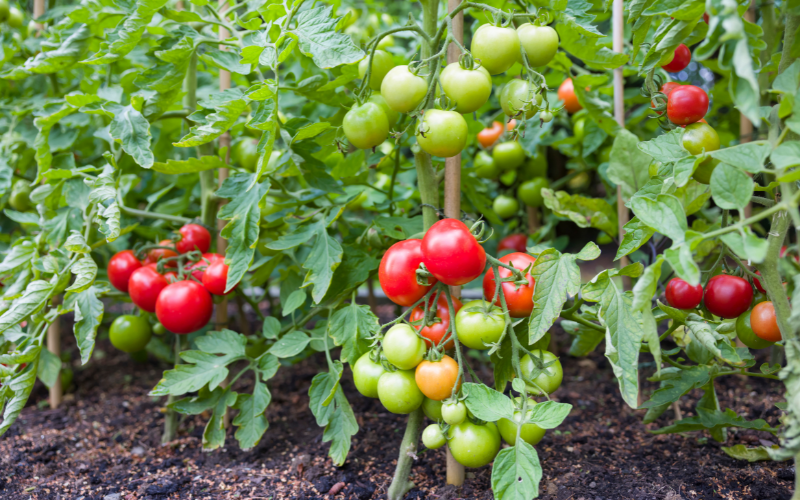Tomatoes, those juicy and versatile fruits, are a staple in many home gardens. Whether you’re a seasoned gardener or a beginner with a green thumb, understanding the proper spacing for planting tomatoes is key to ensuring a bountiful harvest. In this article, we’ll delve into the question that every tomato enthusiast asks: “How far apart should I plant my tomatoes?” So grab your gardening gloves and let’s dig in to learn how far apart to plant tomatoes for optimal growth!
Why is Proper Spacing Important?
Tomatoes, like most plants, need adequate space to grow and thrive. Proper spacing between tomato plants allows for better air circulation, reduces the risk of diseases, and enables each plant to receive sufficient sunlight and nutrients. By giving your tomatoes the room they need, you’ll maximize their potential and increase your chances of enjoying a fruitful harvest.
Determining the Ideal Tomato Spacing:
The ideal spacing for tomato plants depends on several factors, including the variety of tomatoes, the type of support system used, and the available space in your garden. Here are some general guidelines to help you determine how far apart to plant your tomatoes:
1. Determinate vs. Indeterminate Varieties:
Tomatoes can be categorized into two main types: determinate and indeterminate. Determinate tomatoes grow to a certain height and set fruit all at once, while indeterminate tomatoes continue to grow and produce fruit throughout the season. The spacing requirements differ for these two types.
For determinate varieties, such as Roma or Celebrity, aim for a spacing of 2 to 3 feet (60 to 90 cm) between plants. This spacing allows them to form compact bushes and facilitates easy support.
Indeterminate varieties, like Beefsteak or Cherry tomatoes, require more space due to their vining growth habit. Provide a spacing of 3 to 4 feet (90 to 120 cm) between plants to allow for the vigorous growth and sprawling nature of these tomatoes.
2. Staking or Caging:
Supporting your tomato plants with stakes or cages not only helps them grow upright but also affects the spacing requirements. When using stakes or cages, you can space your tomatoes closer together compared to when they are left unsupported.
For staked tomatoes, maintain a spacing of 1.5 to 2 feet (45 to 60 cm) between plants. The sturdy support will keep the plants upright, allowing them to receive ample sunlight and airflow.
When using cages, you can increase the spacing slightly to 2 to 3 feet (60 to 90 cm) between plants. The cages provide a more expansive structure for the plants to grow and spread their branches.
3. Available Garden Space:
Consider the overall space in your garden when deciding how far apart to plant tomatoes. If you have limited space, you can opt for closer spacing to make the most of the available area. However, ensure that each plant still has enough room to receive adequate sunlight and airflow.
In larger gardens, you can space your tomato plants further apart, allowing for more air circulation and reducing the risk of diseases. Spacious arrangements also make it easier to access the plants for maintenance and harvesting.
More tips:
In addition to proper spacing, there are a few more tips to optimize the growth of your tomato plants. First, prepare the soil by incorporating organic matter, such as compost or well-rotted manure, to ensure a nutrient-rich environment. Tomatoes are heavy feeders and thrive in fertile soil.

Furthermore, regular watering is crucial for tomato plants. Aim for consistent moisture, avoiding both drought stress and overwatering. Water deeply at the base of the plants to encourage robust root development. For more information about watering tomatoes check out our blog How Often to Water Tomatoes: 11 Tips for Successful Gardening.
Mulching is another beneficial practice for tomato beds. Applying a layer of organic mulch, such as straw or wood chips, around the plants helps retain soil moisture, suppress weeds, and regulate soil temperature. For the best organic mulch for tomatoes click here.
As your tomato plants grow, consider providing additional support, especially for indeterminate varieties. You can use twine or clips to secure the plants to their stakes or cages, preventing them from sprawling on the ground and reducing the risk of disease.
Pruning is also an important technique to promote optimal growth and fruit production. Remove suckers, the small shoots that develop in the leaf axils, to direct the plant’s energy toward fruit development. However, be cautious not to over-prune, as some foliage is necessary to protect the fruits from sunburn.
Regularly inspect your tomato plants for any signs of pests or diseases. Early detection and intervention are key to preventing any major issues. If you notice any problems, consider using organic pest control methods or consult with a local gardening expert for advice.
Finally, don’t forget to harvest your ripe tomatoes when they reach their peak color and firmness. Gently twist or cut the fruits from the vine to avoid damaging the plant.
By combining proper spacing with these additional tips, you’ll set the stage for a thriving tomato garden. Remember, gardening is a journey of learning and experimentation, so don’t be afraid to try new techniques and adapt them to suit your specific circumstances.
Conclusion
Proper spacing is a crucial aspect of successful tomato cultivation. By giving your tomato plants the right amount of room to grow, you’ll enhance their overall health, minimize the risk of diseases, and increase your chances of a bountiful harvest. Remember to consider the tomato variety, the support system used, and the available garden space when deciding how far apart to plant your tomatoes. So go ahead and set up your garden with the appropriate spacing, and soon you’ll be savoring the delicious rewards of your tomato-growing endeavors!
Happy gardening!

